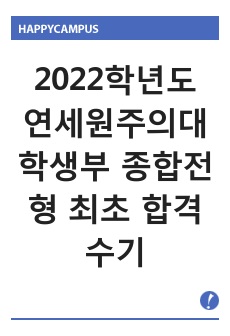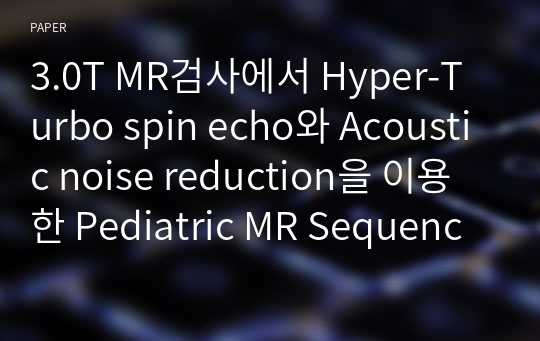3.0T MR검사에서 Hyper-Turbo spin echo와 Acoustic noise reduction을 이용한 Pediatric MR Sequence에 관한 고찰
* 본 문서는 배포용으로 복사 및 편집이 불가합니다.
서지정보
ㆍ발행기관 : 대한자기공명기술학회
ㆍ수록지정보 : 대한자기공명기술학회지 / 26권
ㆍ저자명 : 장일, 황인수, 박용훈, 이용대
ㆍ저자명 : 장일, 황인수, 박용훈, 이용대
목차
Ⅰ. 서 론Ⅱ. 대상 및 방법
1. 대상
2. 검사 장비 및 영상 변수
3. 결과 분석 방법
Ⅲ. 결 과
1. Phantom Test
2. 임상 실험
3. 검정 결과
Ⅳ. 고 찰
Ⅴ. References
한국어 초록
목 적 : 자기공명영상(MRI)의 발달은 소아신경계의 병리학적 과정을 이해하고 진단하는데 중요한 역할을 하고 있으며 그 검사 건수는 나날이 증가하고 있다. 하지만 이같은 장점에도 불구하고 소아의 Brain MR 검사는 환자에게 주의를 주거나 Sedation을 하여 검사를 진행하지만 움직임, 소음 등으로 인하여 실패하는 경우가 발생한다. 고해상력의 영상 획득이 가능한 3.0T의 경우 1.5T에 비해 SAR가 약 4배 증가하게 되며, 최근 미국 소아과학회에서는 어린이가 어른보다 전자파에 더 큰 영향을 받기 때문에 더욱 주의하여 관리해야 한다고 주장하고 있다. 이때, 기존의 TSE가 아닌 다양한 Refocusing FA를 사용하는 Hypere-TSE은 동등한 SNR을 유지하면서 SAR를 감소시키기 때문에 그 해결책이 될 수 있다. 또한, MR 검사 시의 소음은 Gradient의 빠른 Switching을 통해 발생하는데, 이러한 기존의 소음 감소를 위한 Gradient mode인 Whisper mode는 Scan time이 증가하는 등의 단점이 있었으나 최근 E11 Upgrade를 통해 도입된 Acoustic noise reduction는 이를 개선하여 동등한 Scan time과 향상 된 소음 감소 효과를 가져왔다. 이에 본 연구에서는 소아 Brain MRI 검사 시 Hyperecho와 Acoustic Noise Reduction을 이용하여 Image quality를 동등하게 유지하면서 소아를 더욱 안전하고 안정된 환경에서 검사할 수 있는 방법을 제안하고자 한다.대상 및 방법 : 장비는 SIEMENS사의 3.0T SKYRA(Germany)와 32ch Head coil을 사용하였고, Spherical Phantom D165(Siemens, Germany) 및 만 15세 이하의 소아 환자 20명(남자 12, 여자 8, 평균연령 6세)을 대상으로 하였다. Hyper-TSE와 Acoustic noise reduction을 사용했을 때와 사용하지 않았을 때의 T1 Dark fluid(TR: 2000, TE: 9, TI: 900, Matrix: 384*307, FOV: 200*200, NEX: 1) T2WI(TR: 6000 TE: 103, Matrix: 448*269, FOV: 200*200, NEX: 2), T2 FLAIR(TR: 9000, TE: 84, TI: 2500, Matrix: 320*192, FOV: 200*200, NEX: 1)에서 비에스코리아사의 디지털 소음 측정기를 통하여 Isocenter에서 150㎝ 거리에서의 소음을 측정하였고, SAR와 SNR은 Siemens NUMARIS/4 - syngo MR E11로 Gray matter, White matter, Eye ball을 관심 영역 0.02㎠ 측정하여 IBM SPSS Statistics v22.0을 통해 정량적 분석을 하였다.
결 과 : 정량분석 결과 Hyper-TSE와 Acoustic noise reduction을 사용했을 때는 사용하지 않았을 때에 비해 SAR가 T1 Dark fulid에서 -26%, T2에서 -33%, T2 FLAIR에서 –33%로 감소되었으며, 소음은 T1 Dark fulid에서 -14%, T2에서 -16.6%, T2 FLAIR에서 –16.1% 감소하였고, SNR은 T1 Dark fulid에서 GM: 17%, WM: 15%, Eye ball: 12%, T2에서 GM: 10%, WM: 14%, Eye ball: 14%, T2 FLAIR에서 GM: 3%, WM: 9%, Eye ball: 7%로 증가한 것으로 나타났다. CNR은 T1 Dark fulid에서 14%, T2에서 3%, T2 FLAIR에서 –19%로 증감된 것으로 나타났다. 비모수 대응표본 Wilcoxon T검정을 실시한 결과 대부분의 값에서 유의한 차이(p<.05)가 있는 것으로 나타났다.
결 론 : Hyperecho를 사용하게 되면 SNR을 유지하면서 SAR를 상당히 감소시킬 수 있다는 것과 Acoustic noise reduction을 사용할 경우 동일하거나 약간의 검사 시간 증가와 함께 많이 조용하게 된다는 이론적 사실을 바탕으로 안전하고 안정된 환경을 만들기 위해 노력하였다. 이번 연구를 통해 Hyperecho 및 Acoustic noise reduction을 사용할 경우 기존의 Sequence와 비교하여 SAR와 소음은 감소시키면서 SNR과 CNR 값은 동등하거나 증가된 영상을 얻을 수 있고 이를 통하여 소아 환자에게 더욱 안전하고 안정된 환경을 제공하고 효과적이며 진단 가치 높은 영상을 얻을 수 있으리라 사료된다.
영어 초록
Purpose : The development of Magnetic Resonance Imaging(MRI) is playing an important role in understanding the process of pathology in the pediatric neurologic system. The number of tests is increasing daily. However, despite such merits, running the brain MRI on pediatric patients may end up failing. Even though the patient is either given a warning or is sedated during the test, the patient may move or make sounds during the test, which leads to a failure of the test. 3.0T, which produces a high-resolution image, has approximately 4 times higher SAR than 1.5T, so the American Academy of Pediatrics claims that more caution should be taken because young children are more affected by adults. In such case, using Hypere-TSE with refocusing FA instead of the original TSE will not only maintain the same SNR but also reduce the SAR, which means this could be the solution. Moreover, the noise from the MRI is caused by fast switching of the gradient. The whisper mode, a kind of gradient mode, has a demerit of increasing the scan time. However, the acoustic noise reduction introduced through the recent E11 upgrade improved to maintain the same scan time and to reduce the noise. Therefore, a method to run the brain MRI on pediatric patients in a safer and more stable environment while maintaining the same image quality using Hyperecho and Acoustic Noise Reduction is proposed through this study.Materials and Methods : Used equipment is 3.0T SKYRA(Germany) and 32ch Head coil from SIEMENS. Subjects participated in the examination were spherical Phantom D165(Siemens, Germany) and pediatric patients(12 males and 8 females at the average age of 6) at the age of full 15-year-old. T1 Dark fluid(TR: 2000, TE: 9, TI: 900, Matrix: 384*307, FOV: 200*200, NEX: 1), T2WI(TR: 6000 TE: 103, Matrix: 448*269, FOV: 200*200, NEX: 2), and T2 FLAIR(TR: 9000, TE: 84, TI: 2500, Matrix: 320*192, FOV: 200*200, NEX: 1) were measured 150cm away from Isocenter using the digital noise meter from BS Korea. They were measured in cases of using and not using Hyper- TSE and acoustic noise reduction. SAR and SNR were measured using Siemens NUMARIS/4 - syngo MR E11 focusing on the 0.02㎠ area of Gray matter, White matter, and Eye ball, and was quantitatively analyzed through IBM SPSS Statistics v22.0.
Results : As a result of quantitative analysis, SAR was more reduced by -26% at T1 Dark fulid, by -33% at T2, and by -33% at T2 FLAIR when the Hyper-TSE and the acoustic noise reduction were used than when they were not used. The noise was reduced by -14% at T1 Dark fulid, by -16.6% at T2, and by -16.1% at T2 FLAIR. SNR was increased at T1 Dark fulid as following; GM: 17%, WM: 15%, Eye ball: 12%, at T2 as following; GM: 10%, WM: 14%, Eye ball: 14%, and at T2 FLAIR as following; GM: 3%, WM: 9%,Eye ball: 7%. CNR fluctuated by 14% at T1 Dark fulid, 3% at T2, and by -19% at T2FLAIR. When ran the Wilcoxon signed ranks test on matching sample, most of the values showed to have a significant difference (p<.05).
Conclusion : Efforts were made to create a safer and more stable environment with theoretical facts. First, if using Hyperecho, SNR can be maintained, whereas SAR can be significantly reduced. Second, when using Acoustic Noise Reduction, the test time is either same or slightly increased, but significantly quieter. Through this study, an image with reduced SAR as well as same or slightly increased SNR and CNR while using Hyperecho and Acoustic Noise Reduction were obtained by comparing with the original sequence. Through such result, a safer and more stable environment for pediatric patients can be provided, and an image that is more efficient and with a higher value to diagnose can be produced as well.
참고 자료
없음"대한자기공명기술학회지"의 다른 논문
 MRI BRAIN 검사에서 Conventional image와 비교를 통한 MAGIC(Magneti..8페이지
MRI BRAIN 검사에서 Conventional image와 비교를 통한 MAGIC(Magneti..8페이지 경추 MRI검사 시 3D T2 SPACE 영상의 진단적 유용성 평가10페이지
경추 MRI검사 시 3D T2 SPACE 영상의 진단적 유용성 평가10페이지 간세포암 환자의 확산강조영상검사 시 조영제 주입 전·후 현성확산계수의 변화에 대한 연구10페이지
간세포암 환자의 확산강조영상검사 시 조영제 주입 전·후 현성확산계수의 변화에 대한 연구10페이지 방사선사의 직업적 자기장 노출에 따른 발현 증상과 영향 인자8페이지
방사선사의 직업적 자기장 노출에 따른 발현 증상과 영향 인자8페이지 뇌 확산강조 영상 검사시 자체 제작한 보정물의 사용에 따른 영상개선에 관한 연구10페이지
뇌 확산강조 영상 검사시 자체 제작한 보정물의 사용에 따른 영상개선에 관한 연구10페이지 편측 유방 전 절제 환자의 유방 MRI 검사에서 자체 제작한 phantom을 이용한 filling ..8페이지
편측 유방 전 절제 환자의 유방 MRI 검사에서 자체 제작한 phantom을 이용한 filling ..8페이지 Breast Cancer 환자의 breast dynamic 검사 시 ionic contrast 와 ..8페이지
Breast Cancer 환자의 breast dynamic 검사 시 ionic contrast 와 ..8페이지 DBS 환자의 Brain MRI에서 Radiofrequency power 제한기준에 대한 임상적 유..8페이지
DBS 환자의 Brain MRI에서 Radiofrequency power 제한기준에 대한 임상적 유..8페이지 GRAPPA 기법을 이용한 VIBE Sequence검사에서 GRAPPA factor와 ACS Lin..8페이지
GRAPPA 기법을 이용한 VIBE Sequence검사에서 GRAPPA factor와 ACS Lin..8페이지 Multi-steps CE-MRA 검사 시 k-space timing control method10페이지
Multi-steps CE-MRA 검사 시 k-space timing control method10페이지


























